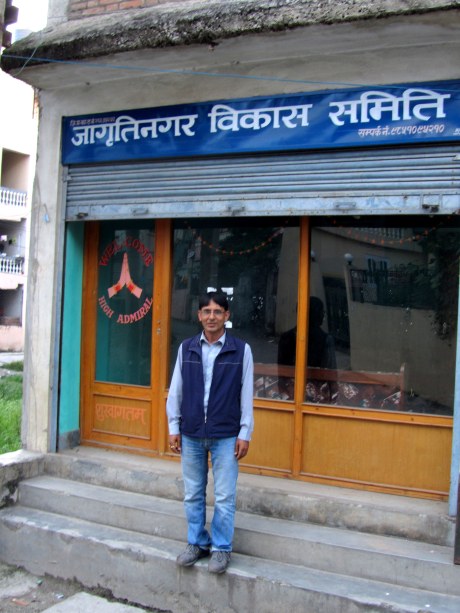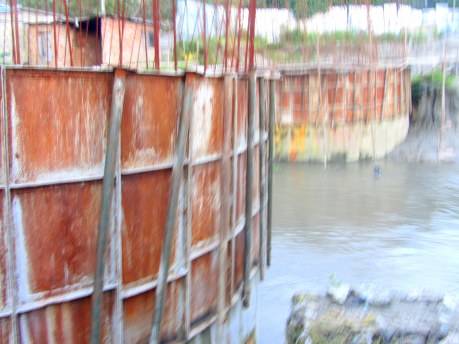On the banks of the Yamuna River at Vrindavan, old, dilapidated pieces of history stand today at the three Ghats, or a series of steps leading to the water level of a river, which are namely Arati Ghat, Akura Ghat, and the famous Kesi Ghat. This Ghat is famous throughout India as it is believed to be the place around which Lord Krishna spent his childhood.
“We started out by raising funds through deusi-bhailo” Moti Ghimire, the president of Jagriti Nagar Tole Bikas Samiti recounts with a smile, “We’ve come a long way.” Jagriti Nagar is a tole, or neighborhood, located on the western bank of the Bagmati river between Naya Baneshwor and Purano Baneshwor. Occupying an area of approximately two hundred square meter with about four hundred homes and small businesses, much of the early history of this tole consisted of people from many districts of Nepal purchasing land and constructing homes in this area, with the first house in this settlement being built around 2046 BS. As the settlement in Jagriti Nagar expanded, a committee was formed in 2048 BS to develop the infrastructure of the tole. However, it took another four years for this entity to be registered with the Central District Office of Kathmandu.
Given the newness of the settlement, the main priority of Jagriti Nagar Bikas Samiti during its early stages was to build proper infrastructure for its denizens. This has led to the gravel roads being upgraded to black-topped roads with the Kathmandu Municipality Corporation (KMC) funding 60% of the project and the other 40% coming through the contributions of the community. With unfailing persistence, the Bikash Samiti has been advocating for a cleaner neighborhood. Despite the fact that Jagriti Nagar is right next to the notoriously dirty Bagmati river, it is relatively clean as the members of the tole have taken the initiative to periodically clean the tole themselves. On the roads of Jagriti Nagar, one can see speed limit signs and marked speed breakers, which are some of the undertakings of the Bikas Samiti. Also, this Bikash Samiti has declared the tole free from sand and gravel exploitation in the neighboring Bagmati river.
Today, Jagriti Nagar Bikash Samiti has diversified in its approach to developing the community. “We do a lot of things throughout the year,” Mr. Ghimire says, “We have blood donation programs. We felicitate those who passed SLC with distinction and the octogenarians of Jagriti Nagar every year. We have community fundraising programs during Dashain and the Nepali New Year. We have a poetry recitation festival. But everything we do, we do it together as a community. No matter where you come from, where you live, it is always important to develop a mutual sense of responsibility.”
In addition to developing a mutual sense of responsibility, the members of the Bikash Samati also believe in developing self-reliance. Hence, the Bikash Samiti does not receive funding from any NGO, INGO or other external development partners. All the office holders in the Bikash Samiti are volunteers and do not receive any form of renumeration. Funding for their activities is derived from the community itself: through a household membership fee of Rs 100 which they collect from every household every two years.
A commendable and exemplary initiative of Jagriti Nagar Bikas Samiti was to search for any annexed public land in the tole that had appeared after the Bagmati river had changed its course. The present working committee was able to identify such land on the eastern part of the tole, on the banks of the Bagmati river. The Management Committee then wrote to the Commission for the Investigation of Abuse of Authority (CIAA) requesting it to look into this particular land and to transfer the ownership to the Nepal Government. CIAA and the branches of the Nepal Government, including the Department of Measurements and Kathmandu District Land Revenue Office, KMC, KMC Ward No. 34 came to the assistance of the Bikash Samiti in gaining control of the public land. After the ensuing litigation, land area of about six and a half ropanies was transferred to the Nepal Government. Several months later, the Bikash Samiti received a formal letter from KMC stating that it was entrusted with safe keeping and building a community park in this land. Again, the Bikash Samiti raised funds from the community to pay for 20% (Rs 291,000) of the proposed park while KMC funded the remaining 80% (Rs 882,000). A boundary wall and a temporary gate have already been constructed.
The Bikash Samiti has also been working with KMC, KMC Ward No. 34 and Nepal Government to raise funds for the construction of a concrete bridge on the Bagmati Bridge. This new bridge, which is already under construction, will connect the Airport section of the Ring Road with the proposed Bagmati Corridor Road. “More work on this bridge has been completed than on the main bridge connecting Purano Baneshwor to Sinamangal” Mr Ghimere states with a smile “To aid the construction of this bridge, we have provided our public land to store steel rods and other construction materials. For this reason, the work on the park has been temporarily put on hold” Mr. Ghimire points to three large circular steel pillars of the bridge under construction, “But as most of the column of the bridge has already been completed, we can hope that we can begin work soon.”
Standing on the banks of the Bagmati river, looking at the bridge being constructed nearby the empty plot of land that will soon become a park, Mr. Ghimire further underscores the fact that “We can’t always ask the government to do everything for us, sometimes we have to take the initiative ourselves. That is what we do with this Bikash Samiti, we provide a platform for the community to take the initiative, to fulfill their needs themselves, to fight for their rights. It is not only enough that we ask for things, it is equally important to work with your neighbors to bring about positive change.”
KRANTIKARKI NOW HAS ITS DOMAIN 🙂
Krantikarki is no longer available at https://krantikarki.wordpress.com.
Future posts will be now available ONLY at http://krantikarki.com
I would thank all of you followers of this blog for making this possible.
Chitij Karki
September, 2011
For more information considering Badrinath, please refer to my other post.

The Himalayas of Uttarakhand are Sacred to Both Sikh and Hindu Pilgrims - Here a Group of Sikh Pilgrims Stop to Rest























